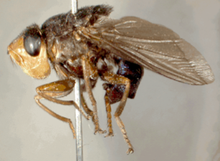Dermatobia
| Dermatobia hominis | |
|---|---|
 |
|
| Adult female human botfly | |
| Scientific classification | |
| Kingdom: | Animalia |
| Phylum: | Arthropoda |
| Class: | Insecta |
| Order: | Diptera |
| Family: | Oestridae |
| Subfamily: | Cuterebrinae |
| Genus: | Dermatobia |
| Species: | D. hominis |
| Binomial name | |
|
Dermatobia hominis (Linnaeus Jr in Pallas, 1781) |
|
| Synonyms | |
|
Oestrus hominisLinnaeus Jr in Pallas, 1781 |
|
Oestrus hominisLinnaeus Jr in Pallas, 1781
The human botfly, Dermatobia hominis (Greek , skin + , life, and Latin , of a human), is one of several species of fly, the larvae of which parasitise humans (in addition to a wide range of other animals, including other primates). It is also known as the torsalo or American warble fly, even though the warble fly is in the genus Hypoderma and not Dermatobia, and is a parasite on cattle and deer instead of humans. An infestation of cattle is shown in the article Parasitic flies of domestic animals.
Dermatobia fly eggs have been shown to be vectored by over 40 species of mosquitoes and muscoid flies, as well as one species of tick; the female captures the mosquito and attaches its eggs to its body, then releases it. Either the eggs hatch while the mosquito is feeding and the larvae use the mosquito bite area as the entry point, or the eggs simply drop off the muscoid fly when it lands on the skin. The larvae develop inside the subcutaneous layers, and after approximately eight weeks, they drop out to pupate for at least a week, typically in the soil. The adults are large flies resembling bumblebees. They are easily recognized because they lack mouthparts (as is true of other Oestrid flies).
This species is native to the Americas from Southeastern Mexico (beginning in central Veracruz) to northern Argentina, Chile and Uruguay, though it is not abundant enough (nor harmful enough) to ever attain true pest status. Some cases have also been reported in Europe. Since the fly larvae can survive the entire eight-week development only if the wound does not become infected, it is rare for patients to experience infections unless they kill the larva without removing it completely. It is even possible that the fly larva may itself produce antibiotic secretions that help prevent infection while it is feeding.
...
Wikipedia
